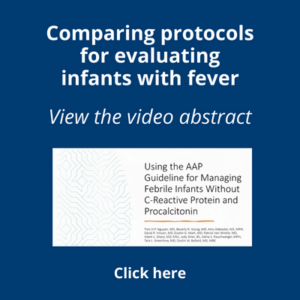Kaiser Permanente research suggests less invasive options for checking infants for infection
When a parent brings a young baby to the emergency department with a fever, the result is often a challenging medical balancing act. The doctors want to rule out a dangerous bacterial infection but without too many invasive tests that can be harrowing for both infant and parent. New Kaiser Permanente research offers insight into that balancing act, suggesting a national clinical guideline may not be ideal in all health care settings.
The study, published December 7 in Pediatrics, examined a 2021 clinical guideline issued by the American Academy of Pediatrics (AAP) for the evaluation of infants 8-60 days old with fever. The study finds that other protocols may actually work better in certain circumstances by requiring fewer infants undergo extensive further evaluation such as invasive lumbar punctures of the spine and treatments such as intravenous antibiotics and hospitalization.

“Evaluating infants with fever is a very common medical problem, and very important part of managing kids, especially in the emergency department or hospital,” said lead author Tran Nguyen, MD, a pediatric hospitalist with The Permanente Medical Group. “If you test every child you will catch every infection, but you will also test some children who do not have infections. Some of these tests are very invasive and you want to use them only as needed.”
The AAP guideline, almost a decade in the making and compiling a large body of evidence, uses a number of different clinical factors, including 2 blood tests for inflammatory markers that may not be available for quick turnaround in all settings. The AAP guideline and several other published protocols for infant fever each have slightly different methods for balancing clinical information about a patient that clinicians then use to decide whether additional, more invasive tests are needed.
The study authors wanted to know how well the AAP guideline stands up without the 2 inflammatory marker tests, said senior author Dustin Ballard, MD, MBE, an emergency physician with The Permanente Medical Group and adjunct investigator with the Kaiser Permanente Division of Research and a member of the KP CREST emergency medicine research network.
The researchers used data from infants seen in Kaiser Permanente Northern California emergency departments between 2010 and 2019 to compare the modified AAP guideline with 4 other published protocols for evaluating infants with fever. These other algorithms use widely available laboratory tests and the patient’s clinical characteristics to screen infants at risk for bacterial infection.
The retrospective study included medical records for 1,433 infants aged 8 to 60 days. Of these, 60 were found to have an invasive bacterial infection, which include bacteremia and meningitis.
The modified AAP guideline performed well in identifying infections when they existed, as did most of the other protocols. Where they differed was in the rate of false positives – the modified AAP guideline had lower specificity compared to most other protocols, meaning that its guidance would have resulted in many more infants undergoing unnecessary invasive interventions such as lumbar punctures, intravenous antibiotics or hospitalizations.
“Particularly for the younger infants less than 28 days old, the AAP guideline is pretty conservative,” meaning it recommends more testing, Ballard said. The results of this analysis suggest clinicians in settings without rapid turnaround of AAP-endorsed inflammatory marker tests may want to consider using a different protocol or approach.

Clinicians may also choose an approach based on the conditions in their community. Infants’ risk for invasive bacterial infections can vary. For instance, babies whose mothers have not had access to regular prenatal medical care may be at greater risk, and would benefit from the more conservative approach. Some communities or health systems may have higher rates of mothers with limited access to prenatal care than others.
At one time, it was standard to give a lumbar puncture, antibiotics, and hospitalization for any baby under 60 days old with a fever, Ballard said, though that approach resulted in many babies without infection having invasive testing and treatment. “Over time, it’s been whittled down so there’s more leeway for other management pathways for the older infants.”
The AAP guideline remains conservative for the younger children aged 8 to 21 days; it is recommended they receive urine analysis, blood culture, lumbar puncture, and intravenous antibiotics in the hospital while awaiting initial test results.
The research team will continue to study the best approach for evaluating infants with fever in a joint project with Kaiser Permanente Southern California.
The study was funded by the Kaiser Permanente Garfield Memorial Fund.
Additional co-authors were Amy Alabaster, MS, MPH, David R. Vinson, MD, Dustin G. Mark, MD, and Adina S. Rauchwerger, MPH, of the Division of Research; Tara L. Greenhow, MD, and Beverly R. Young, MD, of The Permanente Medical Group; Patrick Van Winkle, MD, of the Southern California Permanente Medical Group; Adam L. Sharp, MD, MSc, of the Kaiser Permanente Department of Research and Evaluation; and Judy Shan, BS, of the University of California, San Francisco.
# # #
About the Kaiser Permanente Division of Research
The Kaiser Permanente Division of Research conducts, publishes and disseminates epidemiologic and health services research to improve the health and medical care of Kaiser Permanente members and society at large. It seeks to understand the determinants of illness and well-being, and to improve the quality and cost-effectiveness of health care. Currently, DOR’s 600-plus staff is working on more than 450 epidemiological and health services research projects. For more information, visit divisionofresearch.kaiserpermanente.org or follow us @KPDOR.





Comments (0)